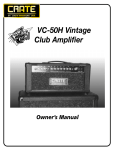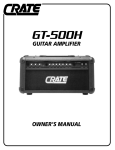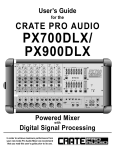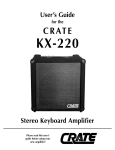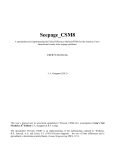Download Crate LS3-231 User`s guide
Transcript
User’s Guide for the C R AT E P R O A U D I O CSM8/12/16/24 Console Mixer In order to achieve maximum performance from your new Crate Pro Audio Mixer we recommend that you read this user’s guide prior to its use. CSM8/12/16/24 Console Mixer Congratulations. You have selected one of the finest pieces of audio reproduction equipment available for use on stage, in the home studio, or for “institutional” use: a Crate Pro Audio Stereo Console Mixer. In order to derive the most benefit from the mixer, and to fully understand and appreciate its flexibility and versatility, please familiarize yourself with the mixer by reading through this User’s Guide prior to its use. And Thank You, from Table of Contents: Introduction . . . . . . . . . . . . . . . . . . . . . . . . . . . .page 3 Features . . . . . . . . . . . . . . . . . . . . . . . . . . . . . . . . . . .3 About This Manual . . . . . . . . . . . . . . . . . . . . . . . . . . .3 The Input Channels . . . . . . . . . . . . . . . . . . . . . . . . . . .4 The Master Section . . . . . . . . . . . . . . . . . . . . . . . . . .5,6 Equalization Diagrams . . . . . . . . . . . . . . . . . . . . . . . . .7 Differences in Cable Types . . . . . . . . . . . . . . . . . . . . . .7 Applications Connecting External Effects . . . . . . . . . . . . . . . . . .8 Basic Mono Operation . . . . . . . . . . . . . . . . . . . . .9 Basic Stereo Operation . . . . . . . . . . . . . . . . . . . .10 DJ Setup . . . . . . . . . . . . . . . . . . . . . . . . . . . . . . .11 House of Worship Installation . . . . . . . . . . . . . . .12 Separating Vocals and Instruments . . . . . . . . . . . .13 System Block Diagram . . . . . . . . . . . . . . . . . . . . . . . .14 Gain Level Diagram . . . . . . . . . . . . . . . . . . . . . . . . . .15 Technical Specifications . . . . . . . . . . . . . . . . .back cover CAUTION PRECAUCION ATTENTION VORSICHT RISK OF ELECTRIC SHOCK DO NOT OPEN RIESGO DE CORRIENTAZO NO ABRA RISQUE D'ELECTROCUTION NE PAS OUVRIR ELEKTRISCHE SCHLAGGEFAHR NICHT OFFENEN CAUTION: TO REDUCE THE RISK OF ELECTRIC SHOCK, DO NOT REMOVE COVER. NO USER-SERVICEABLE PARTS INSIDE. REFER SERVICING TO QUALIFIED SERVICE PERSONNEL. PRECAUCION PARA DISMINUOIR EL RIESGO DE CORRIENTAZO NO ABRA LA CUBIERTA NO HAY PIEZAS ADENTRO QUE EL USARIO PUEDO REPARAR DEJE TODO MANTENIMIENTO A LOS TECHNICOS CALIFICADOS ATTENTION: POUR REDUIRE D'ELECTROCUTION NE PAS ENLEVER LE COUVERCLE. AUCUNE PIECE INTERNE N'EST REPRABLE PAR L'UTILISATEUR. POUR TOUTE REPARATION, S'ADRESSER A UN TECHNICIEN QUALIFIE. VORSICHT: ZUR MINIMIERUNG ELEKTRISCHER SCHLAGGEFAHR NICHT DEN DECKEL ABENHMEN. INTERNE TEILE KONNEN NICHT VOM BENUTZER GEWARTET WERDEN. DIE WARTUNG IS QUALIFIZIERTEM WARTUNGSPERSONAL ZU UBERLASSEN. THIS EQUIPMENT HAS BEEN DESIGNED AND ENGINEERED TO PROVIDE SAFE AND RELIABLE OPERATION. IN ORDER TO PROLONG THE LIFE OF THE UNIT AND PREVENT ACCIDENTAL DAMAGES OR INJURY, PLEASE FOLLOW THESE PRECAUTIONARY GUIDELINES: CAUTION: TO REDUCE THE RISK OF ELECTRIC SHOCK, DO NOT OPEN CHASSIS; DO NOT DEFEAT OR REMOVE THE GROUND PIN OF THE POWER CORD; CONNECT ONLY TO A PROPERLY GROUNDED AC POWER OUTLET. WARNING: TO REDUCE THE RISK OF FIRE OR ELECTRIC SHOCK, DO NOT EXPOSE THIS EQUIPMENT TO RAIN OR MOISTURE. ESTE APARATO HA SIDO DISENADO Y CONSTRUIDO PARA PROVEER ANOS DE OPERACION SEGURA Y CONFIABLE. PARA PROLONGAR LA VIDA DE ESTA UNIDAD E IMPEDIR DANOS ACCIDENTALES POR FAVOR SIGA ESTAS INSTRUCCIONES PREVENTIVAS: PRECAUCION: PARA DISMINUIR EL RIESGO DE DESCARGAS ELÉLECTRICAS: (1) NO ABRA LA CUBIERTA, (2) NO ES RECOMENDABLE REMOVER O DESACTIVAR LA PATA DEL POLO A TIERRA DEL CABLE DE CORRIENTE, CONECTE CORRECTAMENTE A UNA TOMA DE CORRIENTE A TIERRA. ADVERTENCIA: PARA EVITAR DESCARGAS ELECTRICAS O PELIGRO DE INCENDIO, NO DEJE ESTE APARATO EXPUESTO A LA LLUVIA O HUMEDAD. CAUTION: NO USER-SERVICEABLE PARTS INSIDE. REFER SERVICING TO QUALIFIED SERVICE PERSONNEL. PRECAUCION: NO HAY PIEZAS ADENTRO QUE EL USUARIO PUEDE REPARAR. DEJE TODO MANTENIMIENTO A LOS TÉCNICOS CALIFICADOS. CAUTION: OUR AMPLIFIERS ARE CAPABLE OF PRODUCING HIGH SOUND PRESSURE LEVELS. CONTINUED EXPOSURE TO HIGH SOUND PRESSURE LEVELS CAN CAUSE PERMANENT HEARING IMPAIRMENT OR LOSS. USER CAUTION IS ADVISED AND EAR PROTECTION IS RECOMMENDED IF UNIT IS OPERATED AT HIGH VOLUME. PRECAUCION: NUESTROS AMPLIFICADORES PUEDEN PRODUCIR NIVELES DE PRESION DE SONIDO ALTO. EXPOSICION CONTINUADA A LOS NIVELES DE PRESION DE SONIDO ALTO PUEDE CAUSA DANO PERMANENTE A SU OIDO. ES ACONSEJADO QUE USE PRECAUCION AL USUARIO Y ES RECOMENDADO PROTECCION PARA LOS OIDOS SI LA UNIDAD ES OPERADA A VOLUMEN ALTO. THE CHART BELOW SHOWS THE U.S. GOVERNMENT’S OCCUPATIONAL SAFETY AND HEALTH ADMINISTRATION (OSHA) REGULATIONS WHICH WERE IN EFFECT AT THE TIME OF THIS PUBLICATION FOR PERMISSIBLE NOISE EXPOSURE, PER 29CFR1910.95, TABLE G-16: SOUND LEVEL DBA, SLOW RESPONSE 90 92 95 DURATION PER DAY IN HOURS 8 6 4 SOUND LEVEL DBA, SLOW RESPONSE 97 100 102 DURATION PER DAY IN HOURS 3 2 1 - 1 1/2 SOUND LEVEL DBA, SLOW RESPONSE 105 110 115 DURATION PER DAY IN HOURS 1 1/2 1/4 or less ACCORDING TO OSHA, ANY EXPOSURE IN EXCESS TO THESE AMOUNTS LISTED ABOVE COULD RESULT IN SOME HEARING LOSS. EXPLANATION OF GRAPHICAL SYMBOLS: EXPLICACION DE SIMBOLOS GRAFICOS: 2 = "DANGEROUS VOLTAGE" “VOLTAJE PELIGROSO” "DANGER HAUTE TENSION" "GEFAHLICHE SPANNUNG" = "IT IS NECESSARY FOR THE USER TO REFER TO THE INSTRUCTION MANUAL" “ES NECESARIO QUE EL USUARIO SE REFIERA AL MANUAL DE INSTRUCCIONES.” "REFERREZ-VOUS AU MANUAL D'UTILISATION" "UNBEDINGT IN DER BEDIENUNGSANLEITUNG NACHSCHLAGEN" CSM8/12/16/24 Console Mixer Introduction: In the world of professional sound reinforcement and audio reproduction there is no room for compromise. It is absolutely vital that the emotions of a performance are projected to your audience, not just sounds. Your new Crate Pro Audio CSM8/12/16/24 Console Mixer is a powerful tool which allows you to successfully bridge the gap between performers and audience without losing any of the “life” of the performance in the process. No matter what your particular application, your Crate Pro Audio mixer is ready to meet the challenge with a level of performance and control unequaled by its competition. Crate Pro Audio mixers are the result of our interest in and experience with high-performance audio equipment, combined with our extensive research and development procedures, and guided by our love of musical performances. Each mixer is built using a variety of innovative construction methods making it truly reliable and incredibly roadworthy. Its diverse features offer you an extremely high degree of versatility and flexibility regardless of the application. The mixer has been thoughtfully designed to keep you constantly in total control of your performing environment, always with the best possible sound. Features: Crate Pro Audio CSM8/12/16/24 mixers combine the latest technology with contemporary styling and flexible features. In addition, their exceptionally low noise, incredible headroom make them perfect for use on stage, in the home studio, or for “institutional” use. Each of the input channels offers you the choice of balanced XLR Low-Z or balanced 1/4" Hi-Z Input jacks, an insert jack, a peak/signal LED, gain control, three bands of equalization, four fully-adjustable aux sends, a pan control, mute and PFL switches, and a long range channel fader. The master section offers left, right and mix XLR and 1/4” balanced output jacks, a PFL out jack, stereo Tape In and Out jacks, four aux sends, two stereo aux returns with level and pan controls, dual 11-step LED meters, switchable Phantom Power, a Headphones jack with level control, PFL left, right and mix selector switches, and four master faders: aux 1, left, right, and mix. The color-coded knobs help you know at a glance if you’re reaching for a Level knob, an EQ control, a Pan pot or Master slider. About this Manual: This manual is the compilation of many hours of discussions with engineers, musicians, experts in the field of sound reproduction as well as novices, along with “hands-on” usage and training. While we strive to provide as comprehensive and informative a manual as possible, we realize we cannot convey every application imaginable or answer every possible question. We have endeavored to cover as much as is practical in this owner’s manual and have provided suggested connection diagrams for you to use as a starting point for your application. Your Crate Pro Audio dealer can assist you with additional information, or you can visit us on our website at www.crateamps.com. 3 CSM8/12/16/24 Console Mixer The Input Channels: 1. LOW Z INPUT: The signal output from a low impedance microphone or a low impedance line level signal (such as a line out signal from an instrument amplifier) may be connected here by means of a shielded cable terminated with a male XLR plug. Pin 2 = “+,” pin 3 = “–,” and pin 1 = shield. 2. HIGH Z INPUT: The signal output from a high impedance microphone or a line level signal (such as an instrument, rhythm machine, tape deck, etc.) may be connected here by means of a shielded cable terminated with a male 1/4” plug. Tip = “+,” ring = “–,” and sleeve = shield. 1 2 3 3. INSERT: A signal processor may be connected here by means of a shielded stereo signal cable or shielded “Y” cord. (See page 8.) Ring = send, tip = return, and sleeve = ground. 5 4. PEAK/SIGNAL LED: This LED will illuminate green when a signal is present at the High or Low Z inputs. When the signal nears clipping, the LED will illuminate red. (See Gain control, #5.) 6 5. GAIN: Use this control to set the input signal level for the channel. Adjust this control so the peak LED (#4) flashes on strong signal peaks. 4 6. HIGH: Use this control to adjust the high frequency level for the channel. This control allows for 15dB of cut or boost at 10kHz. Typical equalization diagrams are shown on page 7. 7 8 9 7. MID: Use this control to adjust the midrange frequency level for the channel. This control allows for 15dB of cut or boost at 2kHz. Typical equalization diagrams are shown on page 7. 10 8. LOW: Use this control to adjust the low frequency level for the channel. This control allows for 15dB of cut or boost at 100Hz. Typical equalization diagrams are shown on page 7. 11 12 9. AUX 1, AUX 2: Use these controls to set the channel’s output signal level at the aux 1 and aux 2 send jacks (#17, page 5). These are pre-EQ, pre-fader, and are typically used as monitor sends. Examples of some typical connection methods are shown on pages 8–13. 10. AUX 3, AUX 4: Use these controls to set the channel’s output signal level at the aux 3 and aux 4 send jacks (#17, page 5). These are post-EQ, post-fader, and are typically used as effects loop sends. Examples of some typical connection methods are shown on pages 8–13. 13 14 11. PAN: Use these controls to set the amount of the channel’s output signal sent to the left and right master faders (#30, page 6) and the left and right balanced output jacks (#15, page 5). 12. MUTE: This switch, when depressed, mutes the channel’s output signal sent to the left, right and mix master faders (#30, 31, page 6). 13. PFL: This switch, when depressed, sends the channel’s post-EQ, pre-fader signal to the headphones jack (#28, page 6) and the PFL output jack (#18, page 5). 14. FADER: Use this control to set the channel‘s signal level output sent to the left, right and mix master faders (#31, 32, page 6) and the aux 3 and aux 4 send jacks (#17, page 5). 4 CSM8/12/16/24 Console Mixer The Master Section: 16 15 17 18 19 21 18. PFL OUTPUT JACK: Use this jack to send the channel’s PFL signal outputs to a studio monitor power amp/speaker or to a headphone distribution box for additional monitoring capabilities. 23 24 25 27 26 28 31 19. AUX RETURN JACKS: Use these jacks to return the processed signal from an external effect into the master mix. These jacks are stereo 1/4” connectors – ring = right, tip = left, sleeve = shield. 20. POWER: This switch applies the power to the mixer. The mixer is on when the top of the switch is depressed, off when the bottom of the switch is depressed. The adjacent LED illuminates when the power is on. 29 30 16. TAPE IN/TAPE OUT JACKS: Use these jacks to connect to the record and playback jacks of a cassette tape deck. Because the tape in jacks are fed directly into the left and right master faders, use the tape deck’s output level control or an in-line attenuator to adjust the level of the playback signal. 17. AUX SEND JACKS: Use these jacks to send the aux signals to your monitor amps and/or external effects. Aux 1 and 2 are sends only, while aux 3 and 4 can be used as an effects loop along with the aux 3 and 4 return jacks (#19). (See pages 8–13). The mix for each aux send jack is set by the channel aux controls (#9, 10). The master aux 1 fader (#30, page 6) sets the overall signal output level for the aux 1 jack, while the aux 2, 3 and 4 send controls (#24, page 6) set the overall signal output level for the aux 2, 3 and 4 jacks. 20 22 15. LEFT, RIGHT AND MIX BALANCED OUTPUTS: Use these jacks to send the mixer’s output signal(s) to the house power amplifier(s) (see pages 9–13). For the XLR jacks, pin 2 = “+,” pin 3 = “–,” and pin 1 = shield. For the 1/4” jacks, tip = “+,” ring = “–,” and sleeve = shield. 32 21: OUTPUT LED METERS/PEAK INDICATORS: These LED meters monitor the output signals sent to the balanced output jacks (#15). The meter selector switch (#22) determines whether the meters monitor the left and right output signals or the aux 1 and mix output signals. When the LEDs illuminate into the upper red areas, the signals are near clipping and may need to be reduced to avoid distortion. 22: METER SELECTOR SWITCH: When the switch is in the out position, the LED meters (#21) monitor the left and right output signals. When the switch is depressed, the LED meters monitor the aux 1 and mix output signals. (continued...–––––>) 5 CSM8/12/16/24 Console Mixer The Master Section (continued): 16 15 17 18 19 23: PHANTOM POWER: This switch, when depressed, applies 48 volts DC to pins 2 and 3 of the each channel’s low Z input jacks (#1, page 4) to accommodate microphones which require a source of phantom power for proper operation. (Mics not requiring phantom power are not affected by the presence of the DC voltage.) 24. AUX SEND LEVELS: Use these controls to set the output levels for the signals at the aux 2, 3 and 4 send jacks (#17, page 5). 20 25. AUX RETURNS: Use these controls to adjust the level of the signals from the aux 3 and 4 return jacks (#19, page 5). 26. AUX PANS: Use these controls to set the balance of the aux 3 and 4 return signal sent to the left and right master faders (#31). 21 27. HEADPHONES/PFL LEVEL: Use this control to adjust the output signal level at the headphones/PFL jack (#28). 22 28. HEADPHONES/PFL JACK: Use this jack to connect a pair of stereo headphones to the mixer. The signal at this jack is taken from the PFL bus, therefore the channel PFL buttons must be depressed in order to hear their signals through the headphones. 23 24 25 27 26 28 30. AUX 1 MASTER FADER: Use this control to set the overall output signal level at the aux 1 send jack (#17, page 5). A fader has been chosen to provide ease of control of aux 1 since this is typically used as an output signal for the stage monitors. 29 30 31 29. PFL LEFT/RIGHT/MIX: These switches, when depressed, send the corresponding PFL signals to the headphones/PFL jack (#28) and to the PFL output jack (#18). 32 31. LEFT/RIGHT MASTER FADERS: Use these controls to set the overall output signal levels at the left and right balanced output jacks (#15, page 5), as well as the signal level sent to the mix master fader (#32). 32. MIX MASTER FADER: Use this control to set the overall output signal level at the mix balanced output jacks (#15, page 5). The left and right master faders (#31) must be set at an appropriate level so that a signal of sufficient amplitude is sent to the mix master fader. 6 CSM8/12/16/24 Console Mixer Equalization Diagrams: Each input channel of the CSM8/12/16/24 has three bands of equalization which let you alter the tonal characteristics of the input signal. The EQs may be used to add “color” or to compensate for inadequacies of the original signal. They also may be used to cut frequencies to help eliminate unnatural sounds or to de-emphasize over-pronounced tones, and to help prevent acoustic feedback. Each EQ has a range of 30dB (+/-15dB). •The high EQ for each channel is a “shelving” type, with an action point (+6dB) at 6kHz, reaching maximum effect at 10kHz and above. •The middle EQ for each channel is a “peaking” type, which affects frequencies from 800Hz to 5kHz, centered at 2kHz. •The low EQ for each channel is a “shelving” type with an action point (+6dB) at 250Hz, reaching maximum effect at 100Hz and below. +20 +10 0dB -10 -20 20 Hz 50 100 200 500 1k 2k 5k 10k 20k Differences in Cable Types: This manual makes reference to different types of cables; in particular, balanced and unbalanced signal cables and speaker cables. These are not the only types of cables associated with sound reinforcement, but they are similar enough to each other to warrant a more descriptive explanation. For example, the three 1/4”-terminated cables below may look alike at first, but upon closer examination their differences become apparent. BALANCED SIGNAL CABLE: TIP TIP RING SLEEVE TIP = SIGNAL "+" (IN-PHASE) RING = SIGNAL "-" (OUT-OF-PHASE) SLEEVE = SHIELD RING SLEEVE Care must be taken to avoid using SIGNAL cables in place of SPEAKER cables and vice-versa. UNBALANCED SIGNAL CABLE: TIP TIP TIP = SIGNAL SLEEVE = SHIELD SLEEVE SLEEVE SPEAKER CABLE: TIP TIP SLEEVE Signal cables aren’t made to handle the power which speaker cables do; speaker cables are not shielded and pick up external signals, resulting in excessive hum and buzzing. TIP = SIGNAL "+" SLEEVE = SIGNAL "-" *Speaker cables typically do not use or require a shield. SLEEVE BALANCED MIC CABLE: 1 2 3 PIN 2 = SIGNAL "+" (IN-PHASE) PIN 3 = SIGNAL "-" (OUT-OF-PHASE) PIN 1 = SHIELD 7 CSM8/12/16/24 Console Mixer Connecting External Signal Processors: There are several ways to use external signal processors with the CSM8/12/16/24. Each of the mixer’s input channels has its own Insert jack, allowing a processor to be used on that particular channel. Figures 1 and 2 below show two ways of connecting a signal processor to the channel Insert jacks. The mixer’s master section has two stereo effects loops available (Aux 3 and Aux 4), allowing a processor to be added to any or all of the input signals. Figures 3 and 4 below show the basic connection of two types of stereo processors to the aux loops. Each channel’s Aux 3 and Aux 4 levels control the amount of signal sent from each channel to the aux loops. The master Aux 3 and Aux 4 Send, Return and Pan control the amount of signal sent to the processor, the amount of processed signal returned to the mix, and how much of the processed signal is applied to the left and right output signals. (See pages 4 through 6 for additional information on the insert jacks, the aux loops, and their controls.) Figure 1: Connecting an external signal processor to the insert jack of the mixer via the processor's insert jack: Figure 2: Connecting an external signal processor to the insert jack of the mixer via the processor's input/output jacks: INSERT JACK INSERT JACK (TIP = RETURN, RING = SEND, SLEEVE = GROUND) Crate #CYC6MS insert adapter cable Stereo 1/4" T/R/S cable INSERT JACK OUTPUT JACK Figure 3: Connecting an external signal processor to the mixer's aux loop: (Stereo processor with left/right output jacks) AUX 3/ AUX 4 RETURN JACK AUX 3/ AUX 4 SEND JACK (TIP = LEFT, RING = RIGHT, SLEEVE = GROUND) INPUT JACK Figure 4: Connecting an external signal processor to the mixer's aux loop: (Stereo processor with stereo output jack) AUX 3/ AUX 4 RETURN JACK (TIP = LEFT, RING = RIGHT, SLEEVE = GROUND) AUX 3/ AUX 4 SEND JACK Mono 1/4" T/S cable Crate #CYC6MS insert adapter cable Stereo 1/4" T/R/S cable LEFT OUTPUT JACK 8 Mono 1/4" T/S cable RIGHT OUTPUT JACK INPUT JACK STEREO OUTPUT JACK INPUT JACK (See your Crate Pro Audio dealer for the CYC6MS adapter cable.) CSM8/12/16/24 Console Mixer Applications: Basic Mono Operation: This setup shows one way of using the mixer and one stereo power amplifier to run both the house speakers and the stage monitors. Two mono power amplifiers may be used in place of the one stereo amplifier. Connect the components as follows: (A) Connect a balanced or unbalanced signal cable between the mixer’s Mix Balanced Output and the power amplifier’s Channel 1 Input. (B) Connect a speaker cable between the power amplifier’s Channel 1 Outputs and the house speakers’ Inputs. (C) Connect an unbalanced signal cable between the mixer’s Aux 1 Send and the power amplifier’s Channel 2 Input. (D) Connect a speaker cable between the power amplifier’s Channel 2 Outputs and the monitor speakers’ Inputs. (Note the optional use of a graphic equalizer in-line with the connections between the mixer and the power amplifier as shown below.) Please note that the sample connections shown in the Applications sections are only guidelines. They are intended to provide a starting point from which you may assemble a system that will best suit your particular needs. HOUSE SPEAKERS (PS115HD, PS215HDT, etc.) MONITOR SPEAKERS (M112HD, M115HD, etc.) Also note that the models referenced for additional equipment are only suggestions. Your Crate Pro Audio dealer can assist you in selecting the components best suited for your sound system. B CH.1 OUTPUT CH.2 OUTPUT D STEREO POWER AMP (SPA1400, etc.) CH.1 INPUT CH.2 INPUT CH.1 OUTPUT CH.2 OUTPUT DUAL GRAPHIC EQ (LS3231, LS2215) CH.1 INPUT CH.2 INPUT A L R MIX BALANCED OUTPUT C AUX 1 SEND CSM8/12/16/24 (PAN FULL LEFT) (PAN FULL RIGHT) Controlling The Mixer’s Output Levels: • Monitors: Use the Aux 1 master slider (#30, page 6) to set the level of the output signal for the monitors. • Mains (House Speakers): Use the Mix master slider (#32, page 6) to set the level of the output signal for the house speakers. NOTE: The Mix output is a combination of the left and right channels. Therefore, the Left and Right master sliders (#31, page 6) must be set so a signal of sufficient strength is available for the Mix master slider. Use the LED Output Meters (#21, page 5) to visually monitor the output signal levels of the left and right channels. 9 CSM8/12/16/24 Console Mixer Applications: Basic Stereo Operation: This setup shows one way of using the mixer and two stereo power amplifiers to run the system. By using both Aux 1 and 2 for monitor sends, a separate monitor mix can be had for each of two sets of monitor speakers. Connect the components as follows: (A) Connect a balanced or unbalanced signal cable between the mixer’s Left Balanced Output and the house power amplifier’s Channel 1 Input. Connect the Right Balanced Output and the Channel 2 input in the same manner. (B) Connect a speaker cable between the house power amplifier’s Channel 1 Outputs and the left house speakers’ Inputs. Connect the Channel 2 Outputs to the right house speaker in the same manner. (C) Connect an unbalanced signal cable between the mixer’s Aux 1 Send and the monitor power amplifier’s Channel 1 Input. Connect the Aux 2 Send to the Channel 2 input in the same manner. (D) Connect a speaker cable between the monitor power amplifier’s Channel 1 Outputs and one set of monitor speakers’ Inputs. Connect the Channel 2 Outputs to the other set of monitors in the same manner. (Note the optional use of graphic equalizers in-line with the connections between the mixer and the power amplifiers as shown below.) HOUSE SPEAKERS (PS115HD, PS215HDT, etc.) B CH.1 OUTPUT MONITOR SPEAKERS (M112HD, M115HD, etc.) CH.2 OUTPUT D CH.1 OUTPUT CH.2 OUTPUT STEREO POWER AMP (SPA1400, etc.) CH.1 INPUT CH.1 OUTPUT CH.2 OUTPUT STEREO POWER AMP (SPA1400, etc.) CH.1 INPUT CH.2 INPUT CH.1 OUTPUT CH.2 OUTPUT DUAL GRAPHIC EQ (LS3231, LS2215) CH.1 INPUT A CH.2 INPUT DUAL GRAPHIC EQ (LS3231, LS2215) CH.2 INPUT CH.1 INPUT L R LEFT BAL. OUT RIGHT BAL. OUT C CH.2 INPUT AUX1 AUX2 SEND SEND CSM8/12/16/24 (PANS AS NEEDED) (PAN FULL LEFT) (PAN FULL RIGHT) Controlling The Mixer’s Output Levels: • Monitors: Use the Aux 1 master slider (#30, page 6) to set the level of the output signal for one set of monitors and the Aux 2 Send Level (#24, page 6) to set the level of the output signal for the other set of monitors. • Mains (House Speakers): Use the Left and Right master sliders (#31, page 6) to set the levels of the output signals for the house speakers. • Channels: Use the channel Pan controls (#11, page 4) to adjust the level of the signal sent to the left or right outputs. Use the Aux 1 and Aux 2 controls (#9, page 4) to adjust the mix of the signals sent to the monitors. 10 CSM8/12/16/24 Console Mixer Applications: DJ Setup: This setup shows one way of using the mixer and one stereo power amplifier to run the house speakers for a mobile DJ setup. Two mono power amplifiers may be used in place of the one stereo amplifier. Connect the components as follows: (A) Connect a balanced or unbalanced signal cable between the mixer’s Left Balanced Output and the house power amplifier’s Channel 1 Input. Connect the Right Balanced Output and the Channel 2 input in the same manner. (B) Connect a speaker cable between the house power amplifier’s Channel 1 Outputs and the left house speakers’ Inputs. Connect the Channel 2 Outputs to the right house speaker in the same manner. (Note the optional use of a graphic equalizer in-line with the connections between the mixer and the power amplifier as shown below.) HOUSE SPEAKERS (PS115HD, PS215HDT, etc.) B CH.1 OUTPUT CH.2 OUTPUT STEREO POWER AMP (SPA1400, etc.) CH.1 INPUT CH.1 OUTPUT CH.2 OUTPUT CH.2 INPUT DUAL GRAPHIC EQ (LS3231, LS2215) CH.1 INPUT L R L R L R A LEFT BAL. OUT CH.2 INPUT RIGHT BAL. OUT CSM8/12/16/24 (PAN FULL LEFT) (PAN FULL RIGHT) (PAN FULL LEFT) (PAN FULL RIGHT) (PAN FULL LEFT) (PAN FULL RIGHT) Controlling The Mixer’s Output Levels: • Mains (House Speakers): Use the Left and Right master sliders (#31, page 6) to set the levels of the output signals for the house speakers. • Channels: Use the channel Pan controls (#11, page 4) to determine which channel signals are sent to the left and/or right outputs. 11 CSM8/12/16/24 Console Mixer Applications: House of Worship Installation: This setup shows one way of using the mixer and one stereo power amplifier to run both the house speakers and the stage monitors. Two mono power amplifiers may be used in place of the one stereo amplifier. Connect the components as follows: (A) Connect a balanced or unbalanced signal cable between the mixer’s Left Balanced Output and the house power amplifier’s Channel 1 Input. Connect the Right Balanced Output and the Channel 2 input in the same manner. (B) Connect a speaker cable between the house power amplifier’s Channel 1 Outputs and the left house speakers’ Inputs. Connect the Channel 2 Outputs to the right house speaker in the same manner. (C) Connect an unbalanced signal cable between the mixer’s Aux 1 Send and the monitor power amplifier’s Input. (D) Connect a speaker cable between the monitor power amplifier’s Outputs and the monitor speakers’ Inputs. (E) Connect an unbalanced signal cable between the mixer’s Aux 2 Send and the radio feed for broadcasting purposes. (Note the optional use of graphic equalizers in-line with the connections between the mixer and the power amplifiers as shown below.) HOUSE SPEAKERS (PS115HD, PS215HDT, etc.) B CH.1 OUTPUT MONITOR SPEAKERS (M112HD, M115HD, etc.) CH.2 OUTPUT MONO OUTPUT STEREO POWER AMP (SPA1400, etc.) CH.1 INPUT CH.1 OUTPUT CH.2 OUTPUT MONO POWER AMP (SPA1400, etc. in Bridged Mode) CH.2 INPUT MONO INPUT DUAL GRAPHIC EQ (LS3231, LS2215) CH.1 INPUT A D OUTPUT GRAPHIC EQ (LS1131,etc.) CH.2 INPUT C INPUT RADIO FEED PULPIT MIC, LAVALIER MIC, INSTRUMENTS, VOCAL MICS E L R L R LEFT BAL. OUT RIGHT BAL. AUX1 OUT SEND AUX2 SEND CSM8/12/16/24 (PANS AS NEEDED) (PAN FULL LEFT) (PAN FULL RIGHT) (PAN FULL LEFT) (PAN FULL RIGHT) Controlling The Mixer’s Output Levels: • Monitors: Use the Aux 1 master slider (#30, page 6) to set the level of the output signal for the monitors. • Mains (House Speakers): Use the Left and Right master sliders (#31, page 6) to set the levels of the output signals for the house speakers. • Channels: Use the channel Pan controls (#11, page 4) to determine which channel signals are sent to the left and/or right outputs. • Radio Feed: Use the channels’ Aux 2 controls (#9, page 4) and the master Aux 2 Send control (#24, page 6) to set the levels of the signal sent to the radio feed, if broadcasting. 12 CSM8/12/16/24 Console Mixer Applications: Separating Vocals and Instruments: This setup shows one way of using the mixer, one stereo and one mono power amplifier to run the system. Two sets of house speakers are required in this application: one for the vocals, the other for the instruments. Connect the components as follows: (A) Connect a balanced or unbalanced signal cable between the mixer’s Left Balanced Output and the house power amplifier’s Channel 1 Input. Connect the Right Balanced Output and the Channel 2 input in the same manner. (B) Connect a speaker cable between the house power amplifier’s Channel 1 Outputs and the “instruments” house speakers’ Inputs. Connect the Channel 2 Outputs to the “vocals” house speaker in the same manner. (C) Connect an unbalanced signal cable between the mixer’s Aux 1 Send and the monitor power amplifier’s Input. (D) Connect a speaker cable between the monitor power amplifier’s Channel 1 Outputs and the monitor speakers’ Inputs. (Note the optional use of graphic equalizers in-line with the connections between the mixer and the power amplifiers as shown below.) INSTRUMENTS VOCALS HOUSE SPEAKERS (PS115HD, PS215HDT, etc.) B CH.1 OUTPUT MONITOR SPEAKERS (M112HD, M115HD, etc.) CH.2 OUTPUT STEREO POWER AMP (SPA1400, etc.) CH.1 INPUT CH.1 OUTPUT CH.2 OUTPUT MONO OUTPUT MONO POWER AMP (SPA1400, etc. in Bridged Mode) CH.2 INPUT MONO INPUT DUAL GRAPHIC EQ (LS3231, LS2215) CH.1 INPUT A D OUTPUT GRAPHIC EQ (LS1131,etc.) CH.2 INPUT C VOCAL MICS INPUT INSTRUMENTS LEFT BAL. OUT RIGHT BAL. OUT AUX1 SEND CSM8/12/16/24 (PAN FULL RIGHT) (PAN FULL RIGHT) (PAN FULL RIGHT) (PAN FULL RIGHT) (PAN FULL LEFT) (PAN FULL LEFT) (PAN FULL LEFT) (PAN FULL LEFT) Controlling The Mixer’s Output Levels: • Monitors: Use the Aux 1 master slider (#30, page 5) to set the level of the output signal for the monitors. • Mains (House Speakers): Use the Right master slider (#31, page 6) to set the level of the output signal for the house “vocal” speakers. Use the Left master slider (#31, page 6) to set the level of the output signal for the “instrument” house speakers. • Channels: Use the channel Pan controls (#11, page 4) to send the vocal channels to the right channel only and the instrument channels to the left channel only. 13 CSM8/12/16/24 Console Mixer LEFT RIGHT AUX 1 AUX 2 AUX 3 AUX 4 PFL MIX System Block Diagram: LA LEFT TAPE OUT LA RIGHT TAPE OUT SUM PHANTOM POWER ON +48V LA PFL LEFT OFF SUM AUX 1 LOW Z AUX 2 PEAK/ SIGNAL T LA PFL RIGHT LA PFL MIX INSERT R T EQ BA CHANNEL FADER R T MIX FADER MUTE PFL LA SUM R PFL OUT R HEAD PHONES OUT T LA LA BA R PAN T HEADPHONES LEVEL BA AUX 3 RETURN AUX 4 RETURN BA R PAN T SUM BA AUX 3 RETURN 14 SUM LEFT TAPE IN BA RIGHT TAPE IN BA MIX OUT (BAL.) MIX OUT (BAL.) PAN HIGH MID LOW AUX 3 RETURN RIGHT OUT (BAL.) RIGHT OUT (BAL.) AUX 4 GAIN R T RIGHT FADER SUM AUX 3 TYPICAL INPUT CHANNEL HA LEFT OUT (BAL.) LEFT OUT (BAL.) HIGH Z R R T LEFT FADER SUM SUM T LA LEFT LED DISPLAY & PEAK LED RIGHT LED DISPLAY & PEAK LED LED DISPLAY SELECT SWITCH AUX 1 FADER AUX 2 LEVEL AUX 3 LEVEL AUX 4 LEVEL AUX 1 SEND AUX 2 SEND AUX 3 SEND AUX 4 SEND CSM8/12/16/24 Console Mixer Gain Level Diagram: MIC EQ FADER GAIN LINE MASTER FADER PAN INSERT +30 +20 +21dB MAX LINE +26dB +10 MAX MIC +13dB +21dB MAX. INPUT - SET GAIN AS NECESSARY +3dB +15dB MAIN OUT +4dB 0 ALL LEVELS @NOMINAL, GAINS @"10" -10 -20 -30 -17dB -60 -70 -120 dB -13dB -23dB LINE -35dB FULL GAIN -40 -50 -7dB MIC -49dB LINE -55dB MIC -72dB NOISE FLOOR -120dB 15 CSM8/12/16/24 Console Mixer Technical Specifications SYSTEM INPUTS CSM8 CSM12 CSM16 CSM24 All models TAPE INS / TAPE OUTS RCA jacks 47k ohm input impedance +4dBv (1.23V RMS) @ High-Z nominal output Max. Sensitivity -10dBv (.245V RMS) Max. Input Accepted +30dBv (24.5V RMS) 8 mono mic/line input channels 12 mono mic/line input channels 16 mono mic/line input channels 24 mono mic/line input channels 2 stereo effects returns 1 stereo tape input AUX SEND 1/4” phone jacks INPUT CHANNELS Low-Z Mic 1 3-pin “XLR” (balanced, pin 2 = “in phase”) Transformerless electronically balanced 1k ohm load impedance High-Z Line 1 1/4” phone jack (balanced) 10k ohm load impedance EQUIVALENT INPUT NOISE Typically -127dB @ 20 - 12k equivalent bandwidth unweighted with 200 ohm source impedance COMMON MODE REJECTION Typically -90dB min., -70dB @ 50Hz PEAK INDICATOR Indicates point of clipping MAXIMUM SIGNAL ACCEPTED Low-Z Mic 3.46V RMS (13dBv) High-Z Line 15.9V RMS (26dBv) CHANNEL INPUT SENSITIVITY Low-Z Mic All levels up: 8.7mV RMS max. (43dB gain) Channel up only: 2.7mV RMS max. (53dB gain) Gain, channel fader, master fader at max: .28mV. max. (76dB gain) High-Z Line All levels up: 87mV RMS max. (23dB gain) Channel up only: 27mV RMS max. (33dB gain) Gain, channel fader, master fader at max: 28mV. max. (59dB gain) AUX RETURNS 3 & 4 1/4” stereo phone jacks 22k ohm input impedance Max. Sensitivity -26dBv (80mV RMS) Max. Input Accepted +30dBv (24.5V RMS) LEFT & RIGHT OUTPUTS Unbalanced out @ 10k ohm load impedance Balanced @ 3k ohm load impedance +4dBv (1.23V RMS) nominal output 18dBv (6V RMS) max. output DUAL OUTPUT LED/PEAK INDICATORS Type 11 LED quasi-peak Calibration Calibrated to indicate +4dBv @ 8th LED Range -14dBv to +20dBv Signals Read Left and Right Main Outs or Aux 1 and Mix RESIDUAL NOISE 90dB below 1.23V RMS min. with all levels down 70dB below 1.23V RMS with Master Level up full and one channel up full CHANNEL GAIN Typically 65dB adjustment range CHANNEL EQ (ACTIVE) High +/-15dB @ 10kHz shelving Mid +/-15dB @ 2kHz bandpass Low +/-15dB @ 100Hz shelving +4dBv (1.23V RMS) @ High-Z nominal output PHANTOM POWER +48VDC applied to pins 2 and 3 of XLR inputs TOTAL HARMONIC DISTORTION < 0.1% @ 1kHz input @ 5V RMS output (typically 0.05%) measured from Mic In to Main Out (EQ flat) with Master @ nominal “0” setting (-10dB from max. gain), and Gain and Channel Level at max. (At lower input signal levels, measurement is limited by the noise floor) SIZE AND WEIGHT CSM8 20.25” W x 4.25” H x 16.5” D, 21 lbs (514mm x 108mm x 419mm, 9.5kg) CSM12 25.13” W x 4.25” H x 16.5” D, 25 lbs (638mm x 108mm x 419mm, 11.4kg) CSM16 29.75” W x 4.25” H x 16.5” D, 30 lbs (756mm x 108mm x 419mm, 13.6kg) CSM24 40.75” W x 4.25” H x 16.5” D, 39 lbs (1035mm x 108mm x 419mm, 17.7kg) POWER REQUIREMENTS 120VAC 1A Due to ongoing product development and improvement, the specifications contained herein are subject to change without notice. www.crateamps.com ©1999 SLM Electronics, Inc. • A Division of St. Louis Music, Inc. 1400 Ferguson Avenue • St. Louis, MO 63133 18-024-01 • 10/99


















